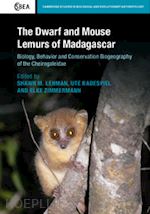List of contributors; Foreword; Part I. Cheirogaleidae: Evolution, Taxonomy, and Genetics: 1. Cheirogaleid diversity and evolution: big questions about small primates; 2. The taxonomy of Cheirogaleidae: an ever expanding species list; 3. Mitogenomics of the family Cheirogaleidae and relationships to taxonomy and biogeography; 4. Why cheirogaleids are bad models of primate ancestors: a phylogenetic reconstruction; 5. Contact zones and species sympatry in dwarf lemurs (Genus Cheirogaleus): the roles of ecological adaptation and sexual selection; Part II. Methods for Studying Captive and Wild Cheirogaleids: 6. How to anesthetize mouse lemurs; 7. Microcebus murinus – a unique primate for modeling human brain disorders, including Alzheimer's disease and bovine spongiform encephalopathy; 8. Life history variation in mouse lemurs: the effect of environmental and phylogenetic determinants; 9. The effects of the lunar cycle, temperature, and rainfall on the trapping success of wild brown mouse lemurs (Microcebus rufus) in Ranomafana National Park, southeastern Madagascar; 10. Tiny samples from tiny lemurs: methodological considerations for endoparasite analyses in mouse lemurs; 11. A review of ectoparasites in the Cheirogaleidae; Part III. Cheirogaleidae: Behavior and Ecology: 12. Morphology, behaviour, ranging patterns and habitat use of the northern giant mouse lemur (Mirza zaza) in Sahamalaza, northwestern Madagascar; 13. Living in riverine and xeric forests: Microcebus griseorufus at Beza Mahafaly, SW Madagascar; 14. Determinants of intra- and interspecific isotopic variation in mouse lemurs from northwestern Madagascar; 15. Your food, my food: patterns of resource use in two sympatric mouse lemur species; 16. The physiology of phyletic dwarfism in Cheirogaleidae; 17. Possible causes and consequences of different hibernation patterns in Cheirogaleus species – Mitovy fatsy sahala; 18. Seed dispersal by mouse lemurs: Do Microcebus represent a unique frugivorous guild?; Part IV. Cheirogaleidae: Sensory Ecology, Communication, and Cognition: 18. Seed dispersal by mouse lemurs: do Microcebus represent a unique frugivorous guild?; 19. Predation in the dark: anti-predator strategies of Cheirogaleidae and other nocturnal primates; 20. The gray mouse lemur (Microcebus murinus): a novel cognitive primate brain aging model; 21. Acoustic divergence in communication of cheirogaleids with special emphasis to mouse lemurs; 22. Modeling the origins of primate sociality: social flexibility and kinship in mouse lemurs (Microcebus spp.); Part V. Cheirogaleidae: Conservation Biogeography: 23. Ecological niche modeling of mouse lemurs (Microcebus spp.) and its implications for their species diversity and biogeography; 24. Edge effects on tree dendrometrics, abiotics, and mouse lemur densities in western dry forests in Madagascar; 25. Factors determining Microcebus abundance in a fragmented landscape in Ankarafantsika National Park, Madagascar; 26. Can behavioural ecology help to understand the divergent range sizes of mouse lemurs?; 27. Conservation biology of the Cheirogaleidae: future research directions; Index.











